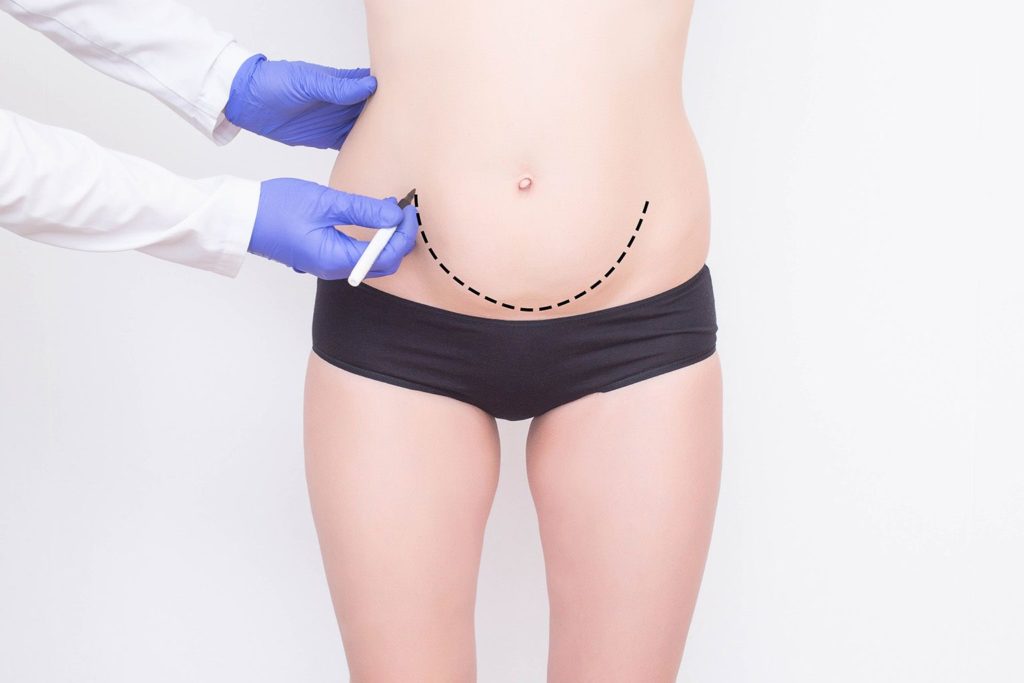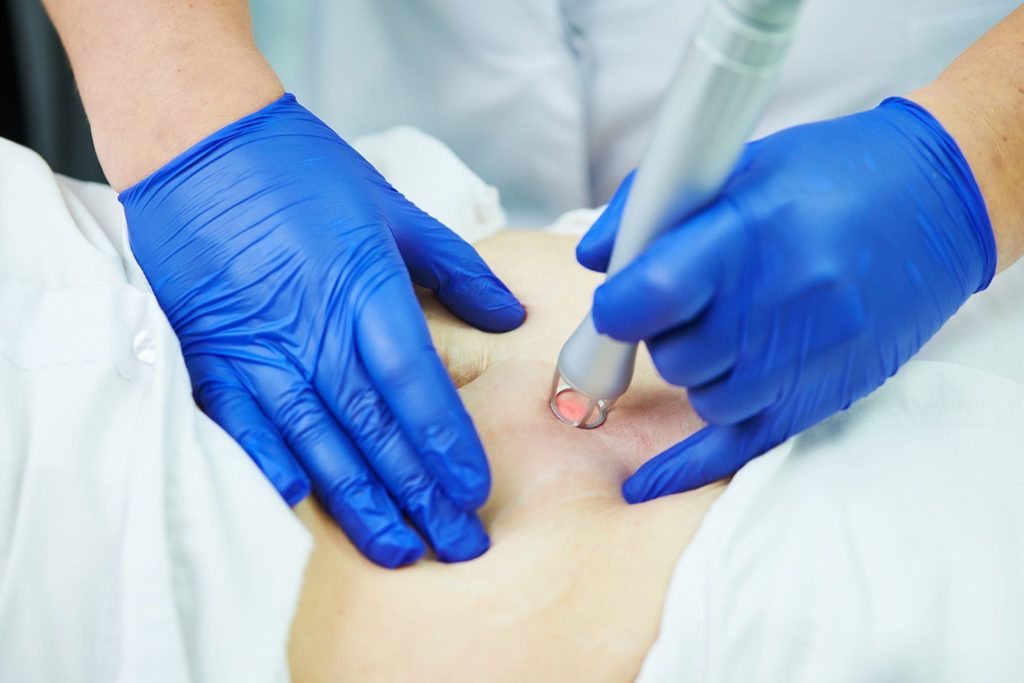Where will the scar from my tummy tuck be located?
Lower abdomen:
Most abdominoplasties leave a horizontal scar at the bottom of the abdomen. It usually extends above the pubic area to the iliac crest (the hard sides of the pelvis that can be easily felt on the lower sides of the flanks). There are some very important aesthetic rules to follow: the distance between the new navel and the scar must be at least 9 to 11 cm. In my patients, it is often 13 to 15 cm. I too often see patients in my clinic who have had surgery at another centre and have a scar that is too high, meaning they cannot hide it at the beach. During the operation, depending on the tension of the skin, it is sometimes necessary to add a short vertical scar in the middle of the horizontal scar. One of the “tricks” to ensure that the horizontal scar is as low as possible is to “fold” the operating table before removing the excess skin and also to apply high tension stitches between the abdominal muscle and the abdominal fascia (the fascia is a layer under the skin of the abdomen). This is essential to ensure that the scar is as low as possible and therefore as aesthetically pleasing as possible, as it will be hidden by underwear or swimwear.
Around the navel:
Full abdominoplasties leave a scar around the navel. Here too, there are “tricks” that can be used during the procedure to make it as inconspicuous as possible. For example, certain techniques can be used to ensure that the scar is well hidden inside the navel when standing upright.
How will my tummy tuck scar evolve over time and how can I minimise its appearance?
Initial healing: weeks 1 to 4
Immediately after a tummy tuck, patients can expect their incisions to be a neat line with some bumpiness in the skin. Your dressings keep the wound closed during the healing process. They are essential to prevent the wound from stretching and to avoid infection. It is counterproductive to remove the dressings at the beginning of the healing process, as this can cause healing problems and make the scar less attractive.
It is important that the dressings do not come into contact with water for up to 3 weeks. We only use absorbable sutures, except around the navel. Sometimes, when there is a T-shaped scar, there may be some healing problems that require regular care. The scar will not be red at this stage.
The less tension there is on the incision, the less likely the scar is to stretch over time. At your post-operative appointment after 3 weeks, we will provide you with a roll of brown Micropore adhesive tape so that you can continue your treatment. Brown Micropore adhesive tape is water-resistant and does not need to be dried with a hairdryer after showering.
Sometimes a “dissolvable” suture does not dissolve properly or quickly enough and pierces the skin. Sutures that come out may appear as a red bump along the incision line before the suture pierces the skin. If this happens, we ask our patients to return to the Bellefontaine Clinic for appropriate care.
From 1 to 6 months
After 3 to 4 weeks, the scars will begin to redden. This is part of the normal healing process. It can take several months (sometimes up to 18 months) for the scar to turn white. After 3 weeks, you can start applying our scar treatment protocol, which consists of using silicone gel sheets and creams to promote healing and minimise the appearance of scars. We use Keli-med® for the cream and Mepiform® for the silicone dressing. LPG or other types of massage can also be used to soften the scar. It is essential to protect your incision from the sun while the scar is red: if your scar turns brown while it is still red, it may remain brown for the rest of your life (although after a year, brown scars can be lightened using laser treatment).
Sometimes there is still a slight excess of skin and fat at both ends of the incision (known in medical jargon as a pig’s ear). If it is small, it will usually soften and become less visible when the scar is “finished”, approximately 8 to 12 months after the operation. If it persists, a small surgical correction can be made under local anaesthetic 6 to 12 months later.
Long-term maturation: 1 year or more
After a year, the scar from a tummy tuck will have changed from red to pink, then to a colour similar to that of the surrounding skin. It should also be flat and smooth. If you have done your research, you may have seen that some tummy tuck scars are very wide and unattractive, while others are thin. Here too, there are “tricks” that can be used during the operation to ensure that the scar is as attractive as possible. For example, using “high tension” sutures minimises tension on the skin scar, allowing it to heal as well as possible and be as thin as possible.
It is important to note that there is a difference in healing after one year between dark skin, which is more prone to hyperpigmentation, i.e. a brown scar after one year even if care has been taken in the sun. Light skin, on the other hand, may experience hypopigmentation, which results in the scar becoming lighter and less visible over time.
After one year, this stage is the ideal time to undergo additional treatments if you wish to further refine your scar.
You may want to consider options such as:
- Laser therapy: Laser treatment such as picoplus laser can improve the appearance of your tummy tuck scar (e.g. reducing the colour of the scar).
- Tattooing: A tattoo can blur the scar by blending it into the surrounding skin or provide an artistic way to conceal the scar.
- Microneedling: Abrasive treatments such as microneedling can help break down existing scar tissue and create a “flatter” appearance.
- Scar revision surgery: In rare cases, patients may choose to undergo a second surgical procedure to correct the scar. However, it is important to be aware that you will need to start treating the scar again for a year as described above.
How can large scars be avoided?
The number one factor in whether or not a large scar will form is excessive tension when closing the skin. To avoid this, as described above, you can “fold” the table during closure and place “high tension” stitches between the muscle and under the skin. Often, those with large scars also have scars that are too high, as this is also one of the reasons why the scar may rise higher than expected. Many factors specific to each patient also influence healing. These include age, diet, genetics, compliance with post-operative instructions, and smoking. We advise you to follow the recommendations above carefully.
FINAL WORD
Abdominoplasty is a very popular plastic surgery procedure: People choose this procedure to refine their figure, feel more comfortable in a swimsuit and feel more confident. Scars are normal after this procedure, and most patients who undergo abdominoplasty are very satisfied with the results and would have the operation again. As you have read, choose a surgeon who will guarantee you a scar without tension and follow the post-operative protocol carefully to ensure that the scar is as inconspicuous as possible. But above all: don’t let scars prevent you from enjoying the benefits of a tummy tuck!



